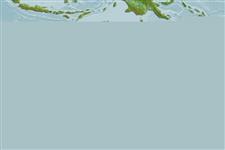>
Carangiformes (Jacks) >
Carangidae (Jacks and pompanos) > Caranginae
Etymology: Pseudocaranx: Greek, pseudes = false + French, carangue, the name of a Caribbean fish; 1836 (Ref. 45335).
Eponymy: J H Wright was said to have “presented many interesting specimens of Botany Bay fishes to the Australian Museum”. [...] (Ref. 128868), visit book page.
More on author: Whitley.
Environment: milieu / climate zone / depth range / distribution range
Ecologia
marinhas; estuarina; intervalo de profundidade ? - 30 m (Ref. 33616). Temperate
Eastern Indian Ocean: southern Australia, from Western Australia to New South Wales.
Tamanho / Peso / Idade
Maturity: Lm ? range ? - ? cm
Max length : 70.0 cm SL macho/indeterminado; (Ref. 9563)
Espinhos dorsais (total) : 9; Raios dorsais moles (total) : 22 - 26; Espinhos anais: 3; Raios anais moles: 18 - 22; Vértebras: 24. This species is distinguished by the following characters: posterior margin of upper jaw canted posteroventrally; the lachrymal and expanded part of the maxilla densely covered with scales; a well-defined opercular spot, nearly solid black and approximately the diameter of the pupil; caudal vertebra 14; gill rakers, upper 10-15, lower 24-28, total 35-43; lateral line with 37-48 scales in the curved portion and 24-35 posterior scutes; never developing a yellow mid-lateral body stripe; second dorsal and anal fins transparent or dusky green, no yellow
pigmentation. (Ref. 76781).
Adults occur over sand and seagrass (Ref. 26068) in coastal waters including estuaries (Ref. 9563).
Life cycle and mating behavior
Maturidade | Reprodução | Desova | Ovos | Fecundidade | Larvas
Paxton, J.R., D.F. Hoese, G.R. Allen and J.E. Hanley, 1989. Pisces. Petromyzontidae to Carangidae. Zoological Catalogue of Australia, Vol. 7. Australian Government Publishing Service, Canberra, 665 p. (Ref. 7300)
Categoria na Lista Vermelha da IUCN (Ref. 130435: Version 2024-2)
Ameaça para o homem
Harmless
Utilização humana
Pescarias: pescarias de subsistência
Ferramentas
Relatórios especiais
Descarregue XML
Fontes da internet
Estimates based on models
Preferred temperature (Ref.
123201): 16.1 - 22.8, mean 18 °C (based on 172 cells).
Phylogenetic diversity index (Ref.
82804): PD
50 = 0.5625 [Uniqueness, from 0.5 = low to 2.0 = high].
Bayesian length-weight: a=0.01318 (0.00626 - 0.02776), b=2.96 (2.79 - 3.13), in cm total length, based on LWR estimates for this (Sub)family-body shape (Ref.
93245).
Nível Trófico (Ref.
69278): 3.4 ±0.3 se; based on diet studies.
Resiliência (Ref.
120179): Médio, tempo mínimo de duplicação da população 1,4 - 4,4 anos (Preliminary K or Fecundity.).
Fishing Vulnerability (Ref.
59153): Moderate to high vulnerability (54 of 100).
Nutrients (Ref.
124155): Calcium = 39 [19, 93] mg/100g; Iron = 0.518 [0.278, 1.036] mg/100g; Protein = 19.7 [18.5, 21.0] %; Omega3 = 0.612 [0.332, 1.186] g/100g; Selenium = 8.61 [3.98, 18.59] μg/100g; VitaminA = 9.84 [2.68, 35.36] μg/100g; Zinc = 0.663 [0.453, 0.947] mg/100g (wet weight);
